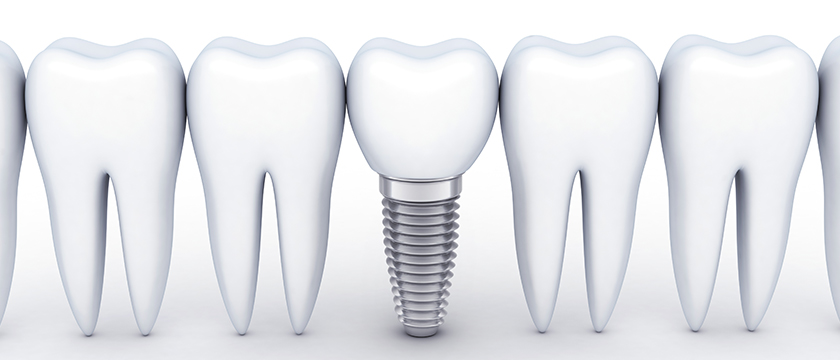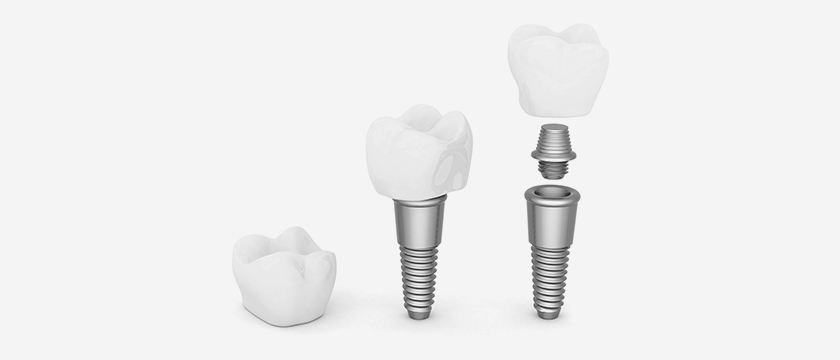In this post, we’ll tell you everything you need to know so you can make an informed decision about whether to move ahead with your plans for dental implant surgery.
So let’s start with the basics.
What is a dental implant treatment exactly?
In essence, a dental implant is an artificial tooth root attached to the jaw at the site of a missing tooth. The artificial root (usually made from titanium) will bond with the bone tissue to create a robust platform or foundation. Once the area is fully stabilised, the titanium root or post is topped with a lifelike crown to complete the transformation.
So what does a dental implant look like?
There is a bit of a misnomer surrounding dental implants, and it’s this:
Many people are under the impression that a dental implant is a tooth itself when it’s only the titanium rod or post. Typically the implant has an abutment attached to it. The abutment is a small hexagonal or octagonal connecting piece that joins the dental crown (the visible restoration you see) to the implant.

So, to make up the restoration as a whole, you have three pieces – the implant, the abutment, and the dental crown.
Getting back to the question, what does a dental implant look like – the answer is that it probably doesn’t look like anything special on its own.
In fact, because of the nature of titanium – if you were to hold it in your hand, it would resemble a post or screw but feel incredibly lightweight, almost like plastic.
Don’t let that deceive you, however. An implant is a highly engineered piece of equipment designed to ensure the best chance of bone fusion (osseointegration). The roughened exterior is deliberately intended to provide the maximum chance of osseointegration taking place. So when dental implant surgery is complete and the post is anchored into the jaw, the implant is less likely to fail.
What does a dental implant surgery treatment look like (and feel like) in the mouth?
Once in position, you may be surprised to know that you won’t feel the implant itself at all. If you do have any feeling, the chances are that it will emanate from the gums surrounding the implant. However, this feeling will only last for a short space of time, and after a while, you won’t even know the implant is there.
Once your permanent crown is in position – after dental implant surgery, the implant and its ensuing parts collectively become part of the mouth.
In reality, people wouldn’t even be able to spot the difference between an artificial implant and a natural tooth – Yes, even dentists! So you smile, and your secret is safe.
What about the subtle differences?
After a successful dental implant procedure, you may want to know how your new restoration feels.
We’ve already mentioned that a titanium implant acts as an artificial tooth root. The key difference between this and an actual tooth root is that a natural root contains nerves whereby you feel sensations such as heat, cold, and pressure.
With an implant, there are no such nerves, so you won’t experience such feelings. Any sensations instead will stem from the nerves in the gum tissue surrounding the implant. Other than this, an implant looks, feels, and acts like a natural tooth in every way.
What does the treatment mean for patients?
After undergoing a dental implant procedure, patients can eat, chew and speak normally. While other restorations like dentures provide much of the same functionality, the bite and chewing capability is only around 30% of the force created by natural teeth.
Ultimately, many denture wearers need to adapt their diet to accommodate dentures. Often, this means avoiding many of the foods they used to enjoy.
With dental implants, bite force is more like 85-95% of natural teeth, so patients really can enjoy the foods they love after undergoing a dental implant procedure without worry.
What about the required ongoing maintenance care for the patient?
After dental implant surgery, ongoing care is critical if you want your dental restoration to continue to look great for many years to come. This means adopting sound oral health practices like brushing and flossing regularly. Also, implant patients should take regular trips to the dentist for ongoing examination and avoid smoking if possible. Smoking can cause bacterial problems, particularly in the early days after dental implant surgery. Finally, dental implants should be used like teeth, not tools for opening bottles or breaking ice.
Bear these factors in mind, and there is no reason why dental implants cannot last for several decades or more.
So there you have it. Hopefully, we’ve answered ‘what dental implants look like’ in detail and talked about how they feel when in the mouth.
If you feel that it’s about time you did something about your imperfect smile and would like more information on how dental implant surgery can change your life, come and talk to the team at DDSS/DDII.
We use the latest digital technology to ensure that your treatment is quicker, better, and more comfortable than you might expect. Call today for an appointment on (02) 8294 8656 (Gosford) or (02) 8294 5812 (Sydney) or book a smile consultation online.
Note: Any surgical or invasive procedure carries risks. Before proceeding, you should seek a second opinion from an appropriately qualified health practitioner.






